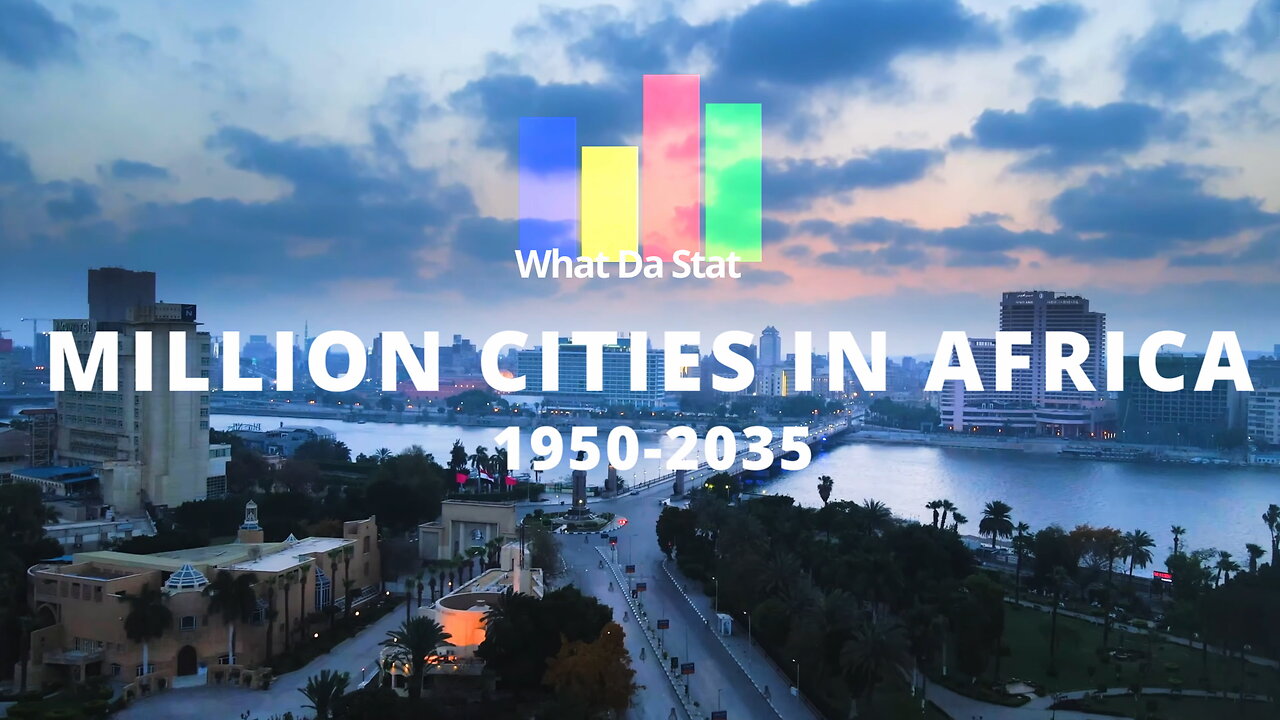Premium Only Content

Million Cities in Africa 1950-2035
This video shows cities in Africa with over one million urban population, and Africa's urbanization in percentage and total urban population, from 1950 to projected in 2035. Countries and their flags are shown as they exist today.
The urbanization trend in Africa has witnessed significant growth since 1950, leading to the emergence of numerous cities with populations exceeding one million.
Many African cities experienced rapid population growth since 1950 due to factors such as rural-urban migration, natural population increase, and economic development. This growth has led to the expansion and densification of urban areas.
Over the decades, several megacities (cities with populations exceeding 10 million) have emerged in Africa, including Lagos (Nigeria), Kinshasa (Democratic Republic of Congo), Cairo (Egypt), and Johannesburg (South Africa). These megacities serve as economic, cultural, and administrative hubs, attracting migrants from both within the country and abroad.
While some regions of Africa have seen rapid urbanization and the emergence of multiple large cities, others have lagged behind in urban development. Countries in North Africa, such as Egypt and Algeria, have relatively higher urbanization rates compared to those in Sub-Saharan Africa, where urbanization has been slower but steadily increasing.
The rapid urbanization of African cities has often outpaced the development of infrastructure, leading to challenges such as inadequate housing, limited access to clean water and sanitation, congestion, and inadequate transportation systems. Informal settlements, characterized by makeshift housing and limited access to basic services, are prevalent in many African cities.
African cities with large populations play crucial roles in their countries' economies, serving as centers for trade, finance, manufacturing, and services. They attract investments, skilled labor, and entrepreneurial activities, contributing significantly to national and regional economic growth.
Despite the challenges, many African governments and municipalities have embarked on urban planning initiatives to manage urban growth effectively, improve infrastructure, and enhance livability. However, implementation often faces constraints such as limited financial resources, institutional capacity, and governance issues.
Urbanization in Africa is expected to continue in the coming decades, driven by factors such as population growth, rural-urban migration, and economic development. This trend will necessitate concerted efforts to address infrastructure deficits, promote sustainable urban development, and enhance the quality of life for urban residents.
Overall, the urbanization of African cities with populations exceeding one million since 1950 reflects the continent's dynamic demographic, economic, and social transformations, presenting both opportunities and challenges for policymakers, urban planners, and residents alike.
Data sources and projections: World Bank and UN
Music: Blue Crystal Star - Eternity https://soundcloud.com/crystalblue64/serinity
Data visualization created with flourish.studio https://flourish.studio
-
 LIVE
LIVE
BonginoReport
3 hours agoJoe Rogan Brings Back Pizzagate (Ep.154) - 03/06/2025
17,117 watching -
 LIVE
LIVE
Wendy Bell Radio
5 hours agoStranded & Abandoned By The Democrat Party
11,183 watching -
 6:05:13
6:05:13
Akademiks
17 hours agoDay 1/30. Drake Drops lawsuit vs iHeartMedia? Offset and Cardi Calls it Quits. 50 v Jim Jones?
218K13 -
 2:55:11
2:55:11
TimcastIRL
14 hours agoDemocrat TANTRUM At Trump Speech BACKFIRES, Trump Polls UP, Dems UNDER FIRE w/67Kevin | Timcast IRL
266K131 -
 1:25:23
1:25:23
Kim Iversen
16 hours agoFrom Doctor to Political Prisoner: Dr. Simone Gold on COVID Lies, January 6th, and Medical Tyranny
151K89 -
 2:09:28
2:09:28
Melonie Mac
17 hours agoGo Boom Live Ep 39!
101K15 -
 1:04:36
1:04:36
Man in America
19 hours ago🚨 BREAKING: Dr. Robert Young JAILED! Medical Tyrants Will Do ANYTHING to Silence Truth
126K69 -
 3:01:44
3:01:44
I_Came_With_Fire_Podcast
17 hours agoPanama CANAL BlackROCKED | Left of PODCASTING | Ukraine AID GONE
66.8K12 -
 45:56
45:56
Glenn Greenwald
16 hours agoLee Fang Reacts to Trump's Speech to Congress; Will DOGE Tackle Military Waste? | SYSTEM UPDATE #418
156K118 -
 43:23
43:23
Donald Trump Jr.
17 hours agoNo Clap: Dems are a Disgrace but My Father is Bringing Back Common Sense | Triggered Ep.222
185K156